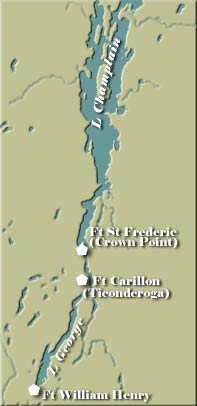In 1755, Governor-General Vaudreuil of New France issued orders to construct a fort at the junction of lakes George and Champlain. Those lakes served as a vital highway for north-south traffic between Canada and lands leading to the Ohio Country. The need for a new stronghold was twofold. First, the French wanted to offer protection to their citizens and Indian allies, who jointly operated the lucrative fur trade. Second, the opening shots of the French and Indian War had already been fired at Great Meadows. The French stronghold in the area, Fort St. Frédéric, was incapable of controlling traffic on the lakes and required reinforcements.
 Construction at the new site began in the fall, but proceeded slowly. Laying the foundation and clearing the site were accomplished simultaneously. After the basic structure of the fort was established and the trees felled, it was discovered that the location did not afford cannon coverage of the narrow portion of Lake Champlain. Rather than begin again, the French constructed a small auxiliary redoubt at a more suitable site.
Construction at the new site began in the fall, but proceeded slowly. Laying the foundation and clearing the site were accomplished simultaneously. After the basic structure of the fort was established and the trees felled, it was discovered that the location did not afford cannon coverage of the narrow portion of Lake Champlain. Rather than begin again, the French constructed a small auxiliary redoubt at a more suitable site.
The main fort was built in the traditional five-pointed star configuration. The space between parallel wooden walls was filled with mud and left to dry. Finally, a sheathing of stone was applied to the walls.
In April 1757, the Marquis de Montcalm, French commander at uncompleted Fort Carillon, expected a major British assault, but decided to take the initiative and moved directly against the British position at Fort William Henry. Montcalm’s forces prevailed, which denied the British their northernmost outpost.
Stung by the loss of Fort William Henry, General James Abercromby led a force of 15,000 British soldiers against the French at Fort Carillon in July 1758. Montcalm decided not to defend the fortress. He occupied a nearby position on high ground. Abercromby unwisely ordered direct assaults against the French, who were protected by a hastily constructed log wall. A day-long battle resulted in a large number of British casualties. They were forced to retreat southward. Their effort to avenge the earlier loss was a total failure.
A year later, in July 1759, a major British offensive was launched against New France. One prong, under James Wolfe, was sent up the St. Lawrence River to lay siege to Québec. The French attempted to counter this threat by moving Montcalm and most of his army from Fort Carillon to Canada. Jeffrey Amherst led the other British contingent up Lake George, intending eventually to join forces with Wolfe. The rendezvous never occurred, but Amherst’s 2,000-man army induced the small remaining French force to desert Carillon, leaving only a delaying party behind. Those soldiers detonated the fort’s powder magazine, but lacked the time to destroy the entire fort before the arrival of the British. Amherst easily captured Carillon, suffered minimal losses, and renamed the prize Fort Ticonderoga* — a name thought to be derived from an Iroquois word meaning “where the waters meet" or "noisy waters.” The French presence was gone from both Carillon and St. Frédéric, which left the British in control of lakes George and Champlain.